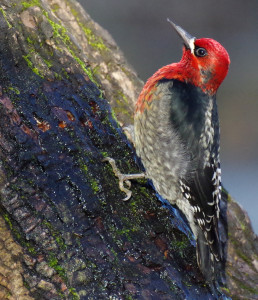 (by Kim Adelson) – Though some of my friends think it weird, I have a tremendous fondness for snags: standing dead or dying trees. They result when trees become diseased, get struck by lightning, find themselves in too much shade, are outcompeted by their neighbors, succumb to drought, or simply reach the end of their lifespan. In a healthy forest, 5-10% of trees are, in fact, snags.
(by Kim Adelson) – Though some of my friends think it weird, I have a tremendous fondness for snags: standing dead or dying trees. They result when trees become diseased, get struck by lightning, find themselves in too much shade, are outcompeted by their neighbors, succumb to drought, or simply reach the end of their lifespan. In a healthy forest, 5-10% of trees are, in fact, snags.
Snags are incredibly important for wildlife. They are used by birds (think owls, Brown Creepers, woodpeckers, wrens, and hawks), mammals (squirrels, porcupines, racoons, bats, and mice), reptiles, and amphibians (for example, tree frogs). Some birds, such as Hairy Woodpeckers, won’t move into an area unless snags are available. They serve numerous functions:
- Cavity nesters either create holes in them (primary excavators, such as Northern Flicker and nuthatches) or use holes created by others (secondary cavity nesters: Wood Duck, Tree Swallow, and Great Horned Owls). In Western Washington alone, 39 species use tree cavities for nesting.
- Snags are insect magnets, and birds including kinglets, woodpeckers and chickadees search them for spiders, ants, bark beetles, termites, as well as other insects’ eggs, larvae, and pupae.
- Hawks, eagles, and owls use them to survey the surrounding terrain when hunting.
- Swallows, pigeons, hummingbirds, and others use them as preferred resting perches.
- Birds such as Clark’s Nutcrackers employ them as larders, and store food in holes they make for that purpose.
- Because they are leafless or needleless, snags provide visible spots for territorial and mating displays. Many passerines use them as song posts, while woodpeckers drum on their resonant wood.
- In my yard, at least, they appear to be preferred after-bath preening sites for numerous bird species.
Different types of snags serve different purposes. Cavity nesters prefer snags with hard sapwood (outer wood) and decayed, soft heartwood (inner core); these easily-excavated trees provide good shelter and insulation. Conversely, foragers—like the insects they feed upon—tend towards snags with soft outer wood. Having a variety of snags, from different types of trees at different stages of decay, will attract the most wildlife. Large snags tend to attract more species than smaller ones.
Since snags are so useful, seriously consider retaining them on your property. Sometimes it even makes sense to create them by hastening a tree’s demise. If you have a diseased or badly damaged tree (heavy fungus cover is a good indication of distress), or if one is simply in the wrong spot (for example, it shades your vegetable patch or has grown too near your septic system’s drainage field), rather than removing it altogether you could turn it into a snag. Take care, of course, that it isn’t placed so that it could eventually fall onto a building or walkway: trees downhill from houses or tilting away from structures are especially good candidates.
There are several methods for creating snags. One of the best is to remove the top third of the tree and about half of the remaining side branches. Alternatively, conifers can be killed by leaving the top intact but removing most of the side branches. With either method, it is best to make jagged rather than smooth cuts as you prune, to provide a more natural appearance and help speed decay when water and debris collect in the furrows. Deep, downward-slanting slits into the heartwood will also hasten decomposition. Girding the tree—removing a ring of bark around its circumference—is not as good a snag-making method, as it encourages rotting from the outside in rather than the inside out.
You can enhance your snags in two ways. First, create some upward-slanting vertical slits along its sides. These provide roosting sites for Brown Creepers as well as bats. Secondly, you can plant a native vine such as trailing blackberry or orange honeysuckle at the base of the snag to replace the color provided by leaves or needles.
I created two deodora pine snags three years ago. They didn’t attract much action for the first two years; this third year, however, although they are surrounded by living trees and shrubs, they are the most active bird sites in my yard. I’ve seen as many as a dozen species using them in a single 10-minute session, and often there are two or three species on the snags at once. If you have a little patience, I am sure snags will pay off for you as well!







